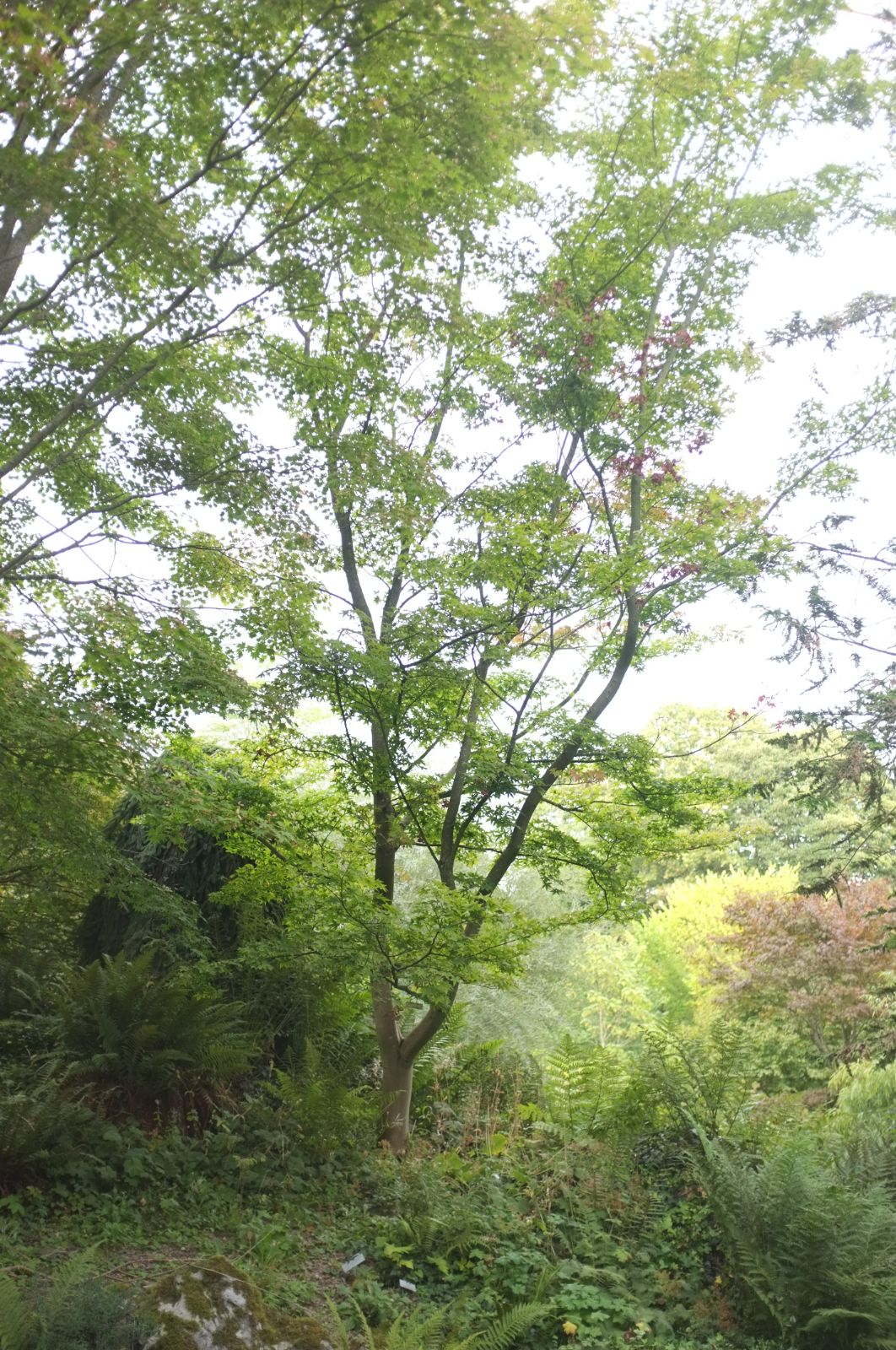Acer pauciflorum
Sponsor
Kindly sponsored by
a member of the International Dendrology Society
Credits
Article from New Trees by John Grimshaw & Ross Bayton
Recommended citation
'Acer pauciflorum' from the website Trees and Shrubs Online (treesandshrubsonline.
Genus
- Acer
- Sect. Palmata, Ser. Palmata
Synonyms
- A. pubipalmatum W.P. Fang
Other taxa in genus
- Acer acuminatum
- Acer amplum
- Acer argutum
- Acer barbinerve
- Acer buergerianum
- Acer caesium
- Acer calcaratum
- Acer campbellii
- Acer campestre
- Acer 'Candy Stripe'
- Acer capillipes
- Acer cappadocicum
- Acer carpinifolium
- Acer 'Cascade'
- Acer caudatum
- Acer ceriferum
- Acer chapaense
- Acer chienii
- Acer circinatum
- Acer cissifolium
- Acer × conspicuum
- Acer cordatum
- Acer coriaceifolium
- Acer × coriaceum
- Acer crataegifolium
- Acer davidii
- Acer diabolicum
- Acer distylum
- Acer divergens
- Acer duplicatoserratum
- Acer elegantulum
- Acer erianthum
- Acer 'Esk Flamingo'
- Acer fargesii
- Acer fenzelianum
- Acer flabellatum
- Acer forrestii
- Acer franchetii
- Acer × freemanii
- Acer fulvescens
- Acer 'Gimborn'
- Acer ginnala
- Acer glabrum
- Acer 'Gold Coin'
- Acer granatense
- Acer grandidentatum
- Acer griseum
- Acer heldreichii
- Acer henryi
- Acer × hillieri
- Acer hookeri
- Acer hyrcanum
- Acer japonicum
- Acer kawakamii
- Acer komarovii
- Acer laevigatum
- Acer laurinum
- Acer laxiflorum
- Acer lobelii
- Acer longipes
- Acer macrophyllum
- Acer mandshuricum
- Acer maximowiczianum
- Acer maximowiczii
- Acer metcalfii
- Acer miaotaiense
- Acer micranthum
- Acer 'Mindavi'
- Acer 'Minorient'
- Acer miyabei
- Acer miyabei × campestre
- Acer monspessulanum
- Acer morifolium
- Acer 'Mozart'
- Acer oblongum
- Acer obtusifolium
- Acer okamotoanum
- Acer oliverianum
- Acer opalus
- Acer orientale
- Acer palmatum
- Acer papilio
- Acer pectinatum
- Acer pensylvanicum
- Acer pentaphyllum
- Acer pentapotamicum
- Acer pictum
- Acer pilosum
- Acer pinnatinervium
- Acer platanoides
- Acer platanoides × amplum
- Acer platanoides × truncatum
- Acer × pseudoheldreichii
- Acer pseudoplatanus
- Acer pseudosieboldianum
- Acer pubinerve
- Acer pycnanthum
- Acer rubescens
- Acer rubrum
- Acer rufinerve
- Acer saccharinum
- Acer saccharum
- Acer sempervirens
- Acer 'Serpentine'
- Acer serrulatum
- Acer shenkanense
- Acer sieboldianum
- Acer sikkimense
- Acer 'Silver Cardinal'
- Acer 'Silver Ghost'
- Acer sinense
- Acer sinopurpurascens
- Acer spicatum
- Acer stachyophyllum
- Acer taronense
- Acer tataricum
- Acer tegmentosum
- Acer tenellum
- Acer tetramerum
- Acer tibetense
- Acer tonkinense
- Acer triflorum
- Acer truncatum
- Acer tschonoskii
- Acer turkestanicum
- Acer tutcheri
- Acer ukurunduense
- Acer velutinum
- Acer wardii
- Acer 'White Tigress'
- Acer wilsonii
- Acer × zoeschense
Small, upright tree 10–12 m; usually smaller in cultivation. Bark grey and slightly fissured. Branchlets green, slender and covered with short hairs. Leaves deciduous, membranous, 4–7.5 × 5–9 cm, palmately five- to seven-lobed, divided to half or three-quarters of their length, upper surface dark green and glabrous or with short light-coloured hairs, lower surface light green, densely covered with white hairs, margins double-serrate, apex acuminate; petiole 2–5 cm long, densely pubescent; autumn colour yellow or orange to maroon. Inflorescence terminal, corymbose with five to nine flowers. Flowers 5-merous, staminate or hermaphrodite; sepals ovate, reddish purple, petals white to cream, broadly ovate, same size as sepals, stamens eight, inserted on the surface of the nectar disc. Samaras 0.9–2 cm long, purplish brown, wings spreading obtusely. Flowering May, fruiting September (China). Van Gelderen et al. 1994, van Gelderen & van Gelderen 1999, Xu et al. 2008; Gregory, in prep. Distribution CHINA: southern Anhui, Zhejiang. Habitat Forests between 600 and 1000 m asl. USDA Hardiness Zone 6–7. Conservation status Not evaluated. Cross-reference K99.
Hairy palms are more often associated with schoolboy jokes than with maples, but the whitish hairs on the leaf undersides help distinguish this species from Acer palm atum, which it otherwise rather resembles. It is a small, rather shrubby tree, but seems to be hardier and more versatile than A. palmatum (although its full potential is still unknown), which may give it a bright future in cultivation (P. Gregory, pers. comm. 2007). Like A. palmatum it has excellent autumn colour, ranging through yellow, orange and scarlet. It was introduced to Europe in the mid-1990s (van Gelderen & van Gelderen 1999) as scionwood from the Japanese collector Masato Yokoi. At the Esveld Aceretum it has achieved 2 m after ten years (Plantentuin Esveld Collections 2006–2008). It had reached North America somewhat earlier, seed having been received at the JC Raulston Arboretum in 1988 from a Chinese source (records are incomplete), growing to 3 m there before being destroyed during the erection of a new building in 2001 (T. Lasseigne, V. Tyson, pers. comms. 2007). A nice young specimen from a 1994 accession was observed at the Arnold Arboretum in May 2006. It has also done very well at the David C. Lam Asian Garden in Vancouver, where it has been growing since seed was received from Hangzhou Botanical Garden in 1993. These trees show an upright habit and are currently about 6 m tall (P. Wharton, pers. comm. 2007). It has displayed only ‘moderate frost resistance’ at Rogów Arboretum (P. Banaszczak, pers. comm. 2007), so should probably be avoided in areas with severe winters.

